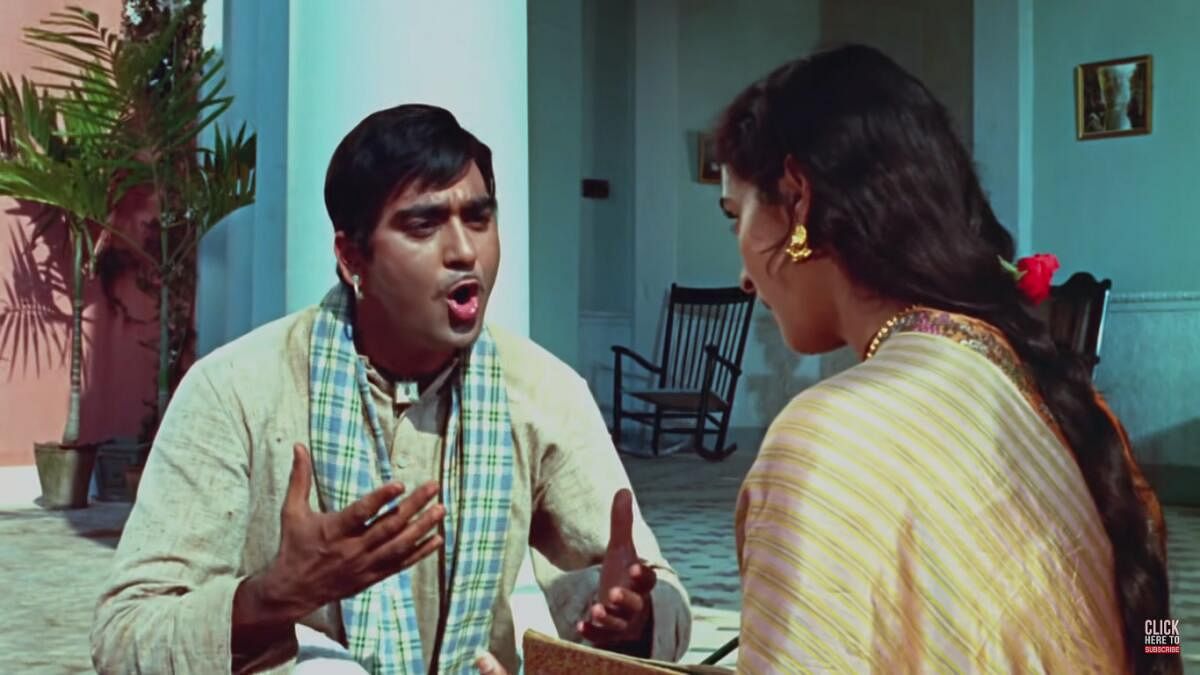

A generation that went to college in the ’80s discovered Mukesh mostly from his ‘sad songs’. It was not that he had no cheerful songs in his oeuvre, but his melancholic songs were requested and played more often on Vividh Bharati, and a comparison with the more exuberant Kishore Kumar contributed to his bluesy reputation. Kishore had appeared on screen in several films, and excelled both at slow and fast numbers. He was singing for a newer generation of actors such as Rajesh Khanna, and was thus seen as a more youthful voice. And the other great male singer ruling the airwaves then was Mohammad Rafi, with his versatile mix of pensive and boisterous numbers.
If you had to find a counterpart for Mukesh in south Indian films, it had to be P B Sreenivas. If Mukesh had a foil in Kishore, Sreenivas had one in S P Balasubramanyam. Mukesh and Sreenivas delivered several hits in an era when heroes lamenting lost love was mandatory in a majority of films. Here is a Mukesh playlist from a music lover who was simultaneously listening to Sreenivas, and a host of other singers such as Hemant Kumar and Manna Dey producing haunting numbers in the thoughtful mode.
Bol Radha bol sangam (Sangam, 1965)
Shot on a playful Raj Kapoor sitting on a tree and a Vyjayantimala swimming around in a pool, it has a bagpipe sound running all through the interludes. Mukesh sounds mellifluous, as always, and the Scottish sound helps Raj Kapoor reimagine the riverside romance celebrated in the mythical Radha and Krishna story.
Mera joota hai Japani (Shri 420, 1955)
The most iconic of Mukesh’s songs, it is shot on a Raj Kapoor dressed as a tramp and doing his Chaplinesque routine. Comparable to such other hits from the era as Awara hoon (Awara), which the Russians famously loved, Kisiki muskurahaton se (Anari), and Dum dum diga diga, this is Mukesh at his cheerful best. ‘Phir bhi dil hain Hindustani’, a line from ‘Mera joota hai Japani’ became the title of a Shah Rukh Khan film many decades later, indicating its enduring appeal.
Jane kahan gaye woh din (Mera Naam Joker, 1970)
With ‘Aansoo bhari hain yeh jeevan ke raahe’ (Parvarish, 1958), this song is perhaps overwhelmingly responsible for giving Mukesh his ‘sad’ reputation. Raj Kapoor, who regarded Mukesh as his singing voice, got him to sing some of his most memorable songs, and used them to compellingly maudlin effect on screen. Based on raga Shivaranjani, ‘Jaane kahan’ inspired dozens of similar songs in the southern languages. And in college parties in Kannada-speaking areas, no party was complete without one of the boys getting up and singing this song about bygone days. Or the equally downbeat ‘Dost dost naa raha’. ‘Full feelingal iddaane,’ his friends would say.
Kabhi kabhie (Kabhi Kabhie, 1976)
A somewhat generic tune, it has an easy appeal, and perfectly suits Mukesh’s slow style. Since it came when Amitabh Bachchan and Shashi Kapoor were in their glory years and were appearing in multi-star sagas, it helped their fans discover Mukesh’s music.
Dil jalta hain (Pehli Nazar, 1948)
After discovering Mukesh, if you went back checking out his discography, you would arrive at his earliest hit. And you would ask if it was K L Saigal. Of course it was Mukesh, singing in the style of a superstar of a preceding era. That exaggerated drag in Mukesh’s voice went away in later songs as he discovered a more contemporary style and his own voice.
Aa laut ke aaja mere meet (Rani Rupmati, 1967):
A younger, more tender Mukesh sings playback for Bharat Bhushan. This lengthy song shows him transitioning to a minimalist, subtly expressive style. Comparable to such other hits as Suhana safar.
Oho re taal mile nadi ke jal mein (Anokhi Raat, 1968)
A philosophical contemplation on the wonder and transience of life, Mukesh’s singing imparts to it a beauty. One of his loveliest songs, it inspired a host of journey songs. Was the Kannada sugama sangeeta singer-composer C Aswath inspired by this number? You definitely hear echoes of this style in some of his songs.